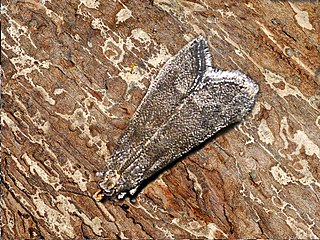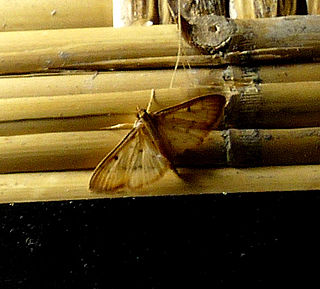
The Luna moth also known as the American moon moth is a Nearctic moth in the family Saturniidae, subfamily Saturniinae, a group commonly known as giant silk moths. It has lime-green colored wings and a white body. The larvae (caterpillars) are also green. Typically, it has a wingspan of roughly 114 mm (4.5 in), but can exceed 178 mm (7.0 in), making it one of the larger moths in North America. Across Canada, it has one generation per year, with the winged adults appearing in late May or early June, whereas farther south it will have two or even three generations per year, the first appearance as early as March in southern parts of the United States.

Carposinidae, the "fruitworm moths", is a family of insects in the order Lepidoptera. These moths are narrower winged than Copromorphidae, with less rounded forewing tips. Males often have conspicuous patches of scales on either surface. The mouthparts are quite diagnostic, usually with prominent, upcurved "labial palps", the third segment long, and the second segment covered in large scales. Unlike Copromorphidae, the "M2" and sometimes "M1" vein on the hindwings is absent. The relationship of Carposinidae relative to Copromorphidae needs further investigation. It is considered possible that the family is artificial, being nested within Copromorphidae. The Palearctic species have been revised by Alexey Diakonoff (1989).

Omiodes continuatalis is a species of moth in the family Crambidae. It is endemic to the Hawaiian islands of Kauai, Oahu, Molokai, Maui, Lanai and Hawaii. It was first cited as possibly extinct by W.C. Gagné and Francis Gard Howarth in 1982. It was listed as extinct by the Hawaiʻi Biological Survey in 2002 and the IUCN in 2003, but was rediscovered later in 2003.

Cataclysta lemnata, the small china-mark, is a moth species of the family Crambidae. It is found in Europe, Morocco and Iran.

Niphopyralis is a genus of snout moths of the subfamily Spilomelinae in the family Crambidae.

Pseudoschinia is a genus of moths of the family Crambidae. It contains only one species, Pseudoschinia elautalis, which is found in North America, where it has been recorded from Arizona, California, Nevada, New Mexico and Texas.

Hellula undalis, the cabbage webworm or Old World webworm, is a moth of the family Crambidae. It is a widespread species which is found from Europe across Asia to the Pacific. It was first described from Italy.

Parapoynx fluctuosalis or Fluctuating China-mark or Waved China-mark, is a moth of the family Crambidae. It is a widespread species, known from Africa, India, Sri Lanka, China, Japan, Malaysia, Taiwan, Guam, Hawaii, Fiji, Australia and the Galápagos Islands. It is also an introduced species in Europe, where it has been recorded from Great Britain, the Iberian Peninsula and Sardinia.
Homoeosoma albosparsum is a moth of the family Pyralidae described by Arthur Gardiner Butler in 1881. It is endemic to the Hawaiian islands of Kauai, Oahu, Maui and Hawaii.

Evergestis frumentalis is a moth of the family Crambidae. It is found from the Iberian Peninsula through southern and central Europe and southern Fennoscandia to central Asia and southern Siberia. The species was first described by Carl Linnaeus in 1761.

Dioryctria albovittella, the pinyon tip moth, is a species of moth of the family Pyralidae. It is found in North America including New Mexico.

Eccopisa is a genus of snout moths. It was described by Philipp Christoph Zeller in 1848.

Cydalima perspectalis or the box tree moth is a species of moth of the family Crambidae, first described by Francis Walker, the English entomologist, in 1859. Native to Japan, China, Taiwan, Korea, far-east Russia and India, it has invaded Europe; first recorded in Germany in 2006, then Switzerland and the Netherlands in 2007, Great Britain in 2008, France and Austria in 2009, Hungary in 2011, then Romania, Spain and Turkey. It has been seen in Slovakia, Belgium and Croatia.

Delplanqueia dilutella is a species of moth in the family Pyralidae. It was described by Michael Denis and Ignaz Schiffermüller in 1775. It is found in most of Europe, east to Russia, Turkey, Iran and Mongolia.

Selagia argyrella is a species of snout moth. It is found in almost all of Europe, except Ireland, Norway, Finland, Estonia, Ukraine and Portugal. In the east, the range extends to Asia.

Phycitodes binaevella is a species of snout moth described by Jacob Hübner in 1813. It is found in most of Europe, Asia Minor, Lebanon and the Palestinian Territories.

Phycitodes maritima is a species of snout moth. It is found in most of Europe.

Moitrelia obductella is a species of snout moth. It is found in most of Europe.
Ancylolomia palpella is a species of moth in the family Crambidae described by Michael Denis and Ignaz Schiffermüller in 1775. It is found in Belgium, France, Spain, Portugal, Italy, Austria, the Czech Republic, Slovakia, Poland, Hungary, Croatia, Romania, Bulgaria, the Republic of Macedonia, Albania, Greece, Ukraine, Russia, Transcaucasia, Asia Minor, Lebanon, the Palestinian territories, Iraq, Syria, Iran and Central Asia.

Herpetogramma basalis is a species of moth in the family Crambidae. It is found on the Canary Islands and in Japan, China, Australia, Sri Lanka, India, Indonesia, La Réunion, South Africa, and Mali.


















